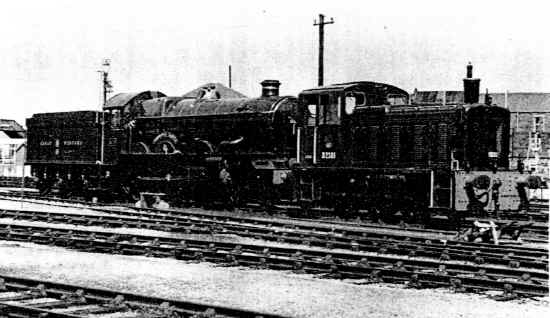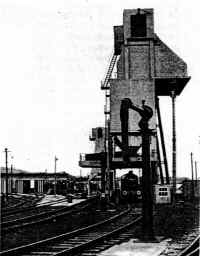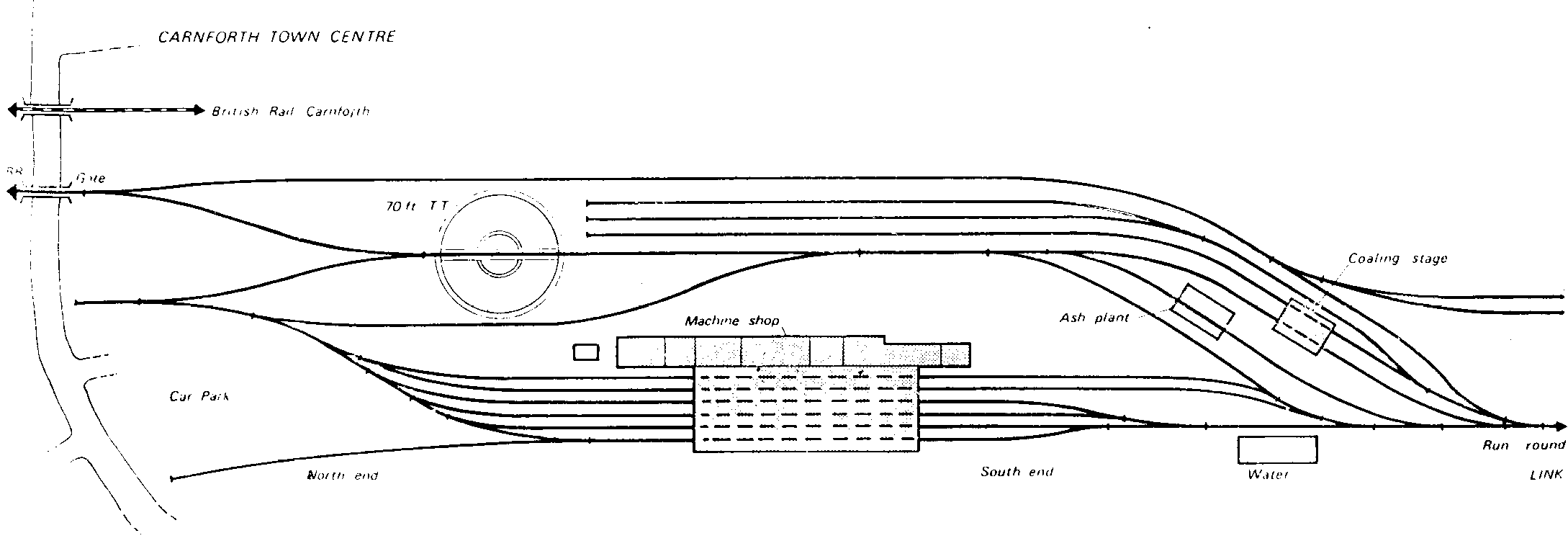Carnforth - ten years on...
TEN years ago this month, the end of steam on British
Railways was reaching a climax. The last official workings were due to take place over the
weekend 3-4 August, with a grand steam finale the following weekend. Locomotive No. 44871
at Carnforth Motive Power Depot on 13 August 1968, was the last locomotive to remain in
steam at a British Railways depot, and that evening its fire was dropped giving it a place
in history. Dennis Lovett takes up the story . . .

Great Western "Pendennis Castle" at
Carnforth prior to its removal whilst en route for Australia.
Photograph was taken in 1977 |
During those last weeks Carnforth had become a popular
place for the many railway enthusiasts who made a pilgrimage there. To someone like me,
who had been born in the 1950's, this was the last opportunity to take in all the delights
and mystery of the machines that had served our railways so well. As a 14-year-old
schoolboy, with a notebook and a Kodak Instamatic camera, I set off for Carnforth, a place
that I had never even heard of, but since then have been unable to forget. Now just a few
minutes from the M6, the place where it all happened 10 years ago remains. And whenever an
opportunity exists, Carnforth MPD or Steamtown, as it is now known, provides an ideal
stopping place on the way north. This article sets out to give an impression of the last
days of steam and the way that Carnforth has retained its features to become one of our
biggest steam centres. In either guise it gives modellers an opportunity to see what
modelling a depot of this size involves, before building a home to house one's collection
of locomotives.

General view of Carnforth depot, looking north |
Historical Notes
Carnforth is situated on the main London-Carlisle main line. This line was built by the
Lancaster & Carlisle Railway, and became part of the London & North Western
Railway in l859. A junction with the Furness Railway line to Barrow was established in
1846. Much mineral traffic was destined for Midland Railway Metals, and the Midland opened
a joint line with the Furness Railway in 1867. This new line connected with the Lancaster
(Green Ayre to Settle Junction on the main Leeds-Carlisle line at Wennington. All three
companies serving Carnforth had locomotive depots in the town, and the situation did not
change until after the grouping when all three companies became part of the LMS in 1923.
The Furness shed was made redundant and the allocation split between the two remaining
sheds. The site of the demolished Furness shed was used for the building of the present
structure during the war (opened in May 1944 . Locally based prisoners of war were
employed during its construction. The ex-LNWR shed was demolished and the Midland shed was
sold to an industrial concern and is still in use to this day. Carnforth remained a
locomotive depot of some importance right up to the end of steam. The shed closed in March
I969 with a diesel allocation) and over 300 men were made redundant. When the last steam
locomotives were being withdrawn, several had been acquired from British Rail with a view
to them being used on the Lakeside line, and were stored on site. From Christmas 1968 two
roads of the shed were leased for steam locomotives to be stored. When the depot closed on
31 March 1969 the rest of the depot was taken over. The Lakeside Railway eventually went
its own way and some of the locomotives went with it. Steamtown, however, had been born,
and since then has become an important asset to the railway preservation movement. With
steam railtours much in demand, Carnforth has become a centre of increasing importance.
Steam locomotives require turning, coaling, etc., and Carnforth, with a 70 ft. turntable
and 150-ton coaling plant, is the ideal place to do it.

An immaculate "Black 5" No 44932 pauses
outside the shed. |
For the modeller
In the 10 years since the end of steam on British Railways, Carnforth MPD has changed very
little. Apart from the conversion of rooms to provide a gift shop and a refreshment room
the lifting of a few sidings and the addition of the small halt for train rides, etc.,
much of the character of 1968 has been retained. This gives the modeller two options in
considering a model of Carnforth MPD. He can either model the site as it was in BR days
or, for those who favour electric and diesel traction, adopt the site in its present role
as a preservation centre. The track plan shows the depot in its present state. By
comparing photographs it is possible to see that the present car park has been extended by
lifting some trackwork which on 3 August 1968 stored redundant locomotives. Ice cream
huts, the small halt, etc., have been omitted from the plan. Anyone considering modelling
a depot of this size will obviously have to reduce the length of the shed, etc., and omit
various details (e.g. the trackwork to the east of the turntable). This will depend on the
amount of space available for the model.
Locomotives in 1968
At the beginning of 1968 steam was very much in decline. Only a handful of depots remained
and some of them (e.g. Carlisle Kingsmoor) were soon closed to steam traction. After the
closure of sheds in the Manchester area from 1 July 1968, only Carnforth, Lostock Hall,
Patricroft and Rose Grove depots retained a steam allocation. The Ian Allan Combined
Volume for 1968 showed the following numbers of ex-LMS and British Railways Standard
locomotives remaining in service at the start of the year: Ivatt 4MT - 11; Black 5 - 175;
8F - 165; Britannia class - 14; Standard 5MT - 23; Standard 4MT - 17; 9F - 24. By the time
3 August came round, only one Britannia remained at Lostock Hall (No. 70013 'Oliver
Cromwell') and a few 8Fs at Patricroft and Rose Grove. Carnforth's allocation was
restricted (according to my own rather vague notes) to the Black 5s. Several other classes
were noted in the scrap lines awaiting disposal. Most of these locomotives are available
in ready-to-run model form. Those currently available are Black 5, (Hornby), 8F (Wrenn),
Britannia (Hornby), Standard 4MT (Mainline and 9F (Hornby). Some will require repainting
and others weathered to represent the rather bleak liveries of latter-day steam. The
Present Day
Steamtown today houses a fine collection of mainline, industrial locomotives and rolling
stock. Several of the large locomotives have been passed for running on British Rail, and
locomotives from other centres are regular visitors. The choice is not only restricted to
British prototypes. The collection includes large express locomotives from both Germany
and France.Amongst the usual residents at Carnforth are: Black 5s no's 44931 44871 44932
(Hornby) ; 6441 Ivatt 2-6-0 (Hornby); 4498 Sir Nigel Gresley (Wrenn); 1306 Mayflower B1
(Bristol Models Kit); 30580 Lord Nelson; 231 K 22 (Jouef); 012-104-6 (Fleischmann).
Manufacturers of models have been shown in brackets. Most models will need a change of
numbers, repainting, etc.
Conclusions
We are indeed fortunate that Carnforth has been retained for us all to enjoy, and as one
of the few remaining ex-BR steam locomotive depots from which modellers can seek details.
In the 10 years since steam ended on British Railways, the preservation movement has come
a long way. When the doors finally closed at Carnforth, it gave many people the
inspiration to open up new ones in all parts of the British Isles. |

The water-tank, Miniature railway tracks are
behind the fence.
|

The concrete coaling stage.
|

B.R. Standard 4-6-0 No 75027 stored out of use at
Carnforth. Taken by the author when 14 years old in August 1968. |

|
Article from "Railway Modeller", August
1978 reproduced by kind permission of Peco
Publications.
[ Media ]
[ Home ]
|






